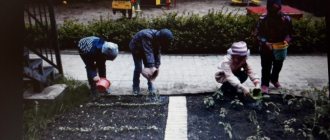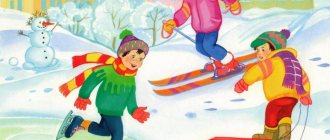Theoretical basis
A walk is a means of introducing children to the nature of their native land. Leisure in the fresh air is a mandatory element of the educational process in kindergarten.
Goals of the walk
The main purpose of the walk is to increase the child’s immunity by adapting the body to the conditions of the outside world. But any pastime in a preschool children's institution has a triune purpose of organization: educational, developmental and educational. Staying outdoors is no exception. There are 4 main goals for spending leisure time on the street in the preparatory group.
- Gaining experience in environmental behavior.
- Recording and analysis of seasonal changes in the external environment.
During walks, children understand what the change of seasons means.
- Development of skills and abilities to monitor changes in the surrounding world.
- Fostering a positive attitude aimed at preserving and caring for flora and fauna, which is the basis of the environmental component of education.
Tasks
To achieve the set goals, systematic work is required to solve the problems that face the teacher organizing the walk.
- Show kids the beauty and perfection of the world created by nature.
- Introduce them to the sights of their hometown, the work of adults who landscape the streets, build houses and pave roads.
Children of the preparatory group are often taken for a walk outside the kindergarten territory
- Demonstrate seasonal changes and associated wardrobe changes.
- Teach children to observe and analyze what is happening around them.
- Raise the level of health care culture, including hygiene (for example, teach people to brush their nose and go to the toilet before a walk, as well as wash their hands, feet and wash their face after).
- Foster a respectful and responsible attitude towards the environment, each other and oneself.
Forms of work
To organize walks in kindergarten, standard forms of working with children for all types of activities are used:
- conversations,
- games,
- listening and retelling fairy tales,
- performing creative tasks, etc.
Requirements for organizing leisure time on the street
Since walking occupies an important place in the structure of the educational process in kindergarten, the requirements for the equipment and sanitary condition of the site are severe.
- The presence of a landscaped, carefully planned area for each age category.
- Equipping places for games - active and calm - with a slide, swings, jumping fences, etc., fun with water, sand and construction materials (cubes, puzzles, etc.).
The slide can be used not only in the warm season, but also in winter
- The opportunity to hide from rain or sun in closed gazebos in spring, autumn, summer, and also to build ice paths and snow structures in winter.
- Daily cleaning of the area. The janitor does this 2-3 times, and the teacher and his assistant maintain cleanliness throughout the day.
Types of walks
Depending on the time spent, leisure time on the street can be:
- morning (before lunch) and evening (after nap) - organized daily,
- winter and summer.
According to the priority of a particular goal, the following are distinguished:
- sports walks (to organize competitions in a specific sport, for example, athletics, are carried out depending on objective circumstances - season and weather - 1-2 times a week),
- targeted (organizing observations of natural phenomena and social life outside the site, for example, in nearby parks - carried out 2 times a week).
Preparation
A rational approach to organizing going outside will prevent kids from getting tired of preparation and will prevent overheating. Before going on a walk, it is necessary that all children brush their nose and go to the toilet. The guys are divided into two subgroups: those with low self-care skills and those with normal self-care skills. After the kids have gone to the toilet, the teacher takes the first subgroup of children to the reception area and helps them get dressed. At this time, the assistant teacher is engaged in carrying out hygiene measures and equipping the second subgroup, after which he sends the children outside. It should be remembered that sick babies are taken out with the second batch, and brought in with the first.
When dressing babies - especially in winter - it is necessary to take into account their high physical activity
Components of a walk and organization of activities with children
In order for staying on the street not to be aimless, it is necessary to know and follow the structure of the combination of components of leisure on the street.
Observations
Recording and analysis of changes in natural phenomena and social life are carried out both with a whole group of children and with individual children. When working with six- to seven-year-olds, 15 to 25 minutes are allocated for this activity every day. At the same time, various objects are offered for consideration, among them:
- representatives of flora and fauna,
- natural phenomena (rain, snow, fog, etc.),
- human labor, for example, a janitor cleaning the territory (such work is organized no more than 1-2 times a month).
Observations are distinguished by type:
- short-term (form ideas about color, shape, size, position of things in space),
- long-term (help to accumulate information about the growth and development of plants and animals, show transformations in nature associated with the change of seasons).
To adequately perceive the observed phenomena, it is necessary to follow a certain sequence of obtaining information:
- establish the facts
Observation is necessary to obtain objective information
- form connections between the elements of one observed object (the wind is getting stronger, the sun is not so hot, the leaves are turning yellow - autumn is approaching),
- accumulate ideas about a particular phenomenon,
- compare facts (heard, seen and already known),
- draw conclusions and establish connections between already known and new information.
Video: observation during a walk in the preparatory group
Labor activity
The purpose of this work is to develop in preschoolers the ability to take on a task, understand its end result, trace the sequence of operations, and also select the necessary working tools. When working with children 6–7 years old, the role of the teacher is reduced to formulating the task and some help if the need arises.
Activities:
- collect garbage from the site (this task will be of a symbolic nature, since the territory is being cleaned by a janitor, but it is still necessary to ensure that the children do not get hurt),
- wipe off dust from outdoor toys,
Washing toys is an excellent option for organizing work activities in the summer.
- water the flowers in the area (or help the teacher bring water),
- choose a tool for making a bird feeder, a birdhouse, and also prepare a workplace, that is, remove everything unnecessary.
It is important. It is worth choosing only the simplest models of bird feeders, so as not to provoke traumatic situations.
Video: how to quickly make a bird feeder from a plastic bottle
Movement is life
Taking into account age characteristics, outdoor games occupy a leading place in the walking process. The selection will depend on the time of year and weather. So, in cool weather in autumn and spring or warm, hot summer, it is worth paying attention to outdoor games with running, jumping, etc. For example, tag, football, volleyball, tennis (large or table tennis) or games with water in June-July. If it’s slushy outside, then it’s better to play games that don’t require active movements and a lot of space—godki, skittles, ring throw, badminton. Since at 6–7 years old children begin to develop elements of competitiveness, play competitions can be held.
In the preparatory group, 20–25 minutes are allotted for outdoor games in the morning during a walk and 12–15 minutes during the afternoon. As for the number of games that kids should master, this usually means learning 2-3 games every month.
You need to complete the stage of outdoor games by walking and reducing physical activity (30 minutes before the end of the walk). Before entering the group, the children put away their toys and wipe their feet.
After playing with snow, be sure to wash your hands and dry your clothes.
Individual work
The teacher must organize children’s leisure time so that each of them is involved in this stage of the educational process. To do this, you need to take into account the child’s temperament and his mood. For some, it might be fun to run with a ball, while for others it might be fun to do balance exercises, and for others it might be fun to step over log obstacles. It is also worth considering the fact that for some children it is much more productive to watch insects and birds than to play sports games.
This is interesting. Some methodological sources highlight another component - independent work. However, for the tasks being solved, it can be added to individual work.





